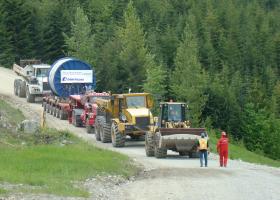
PEAK 2 PEAK Project
OMNITRANS organized the transportation of steel cable manufactured by the respected Swiss company Fatzer, based in Romanshorn. Those cables were needed in Canada, where it was used in the construction of a gondola lift in Whistler (British Columbia).
The new aerial transport system is connecting the peaks of Blackcomb Mountain and Whistler Mountain since December 2008. The Whistler Blackcomb ski resort was the official alpine skiing venue for the 2010 Olympic and Paralympic Winter Games, which was held in Vancouver (Canada).
The record-breaking cableway spans 4.4 km between Whistler Mountain, which is 2,182 m high, and Blackcomb Mountain, which is 2,440 m. The gondola system was built by the aerial cable car specialists Doppelmayr (Austria) and Garaventa AG (Switzerland) and surpasses two world records at one go. The distance between the two supporting masts which are set the farthest apart from each other is 3,024 m. Also, the gondolas dangles 415 m above the floor of the Fitzsimmons Creek valley – the highest ever in the history of aerial cable car construction.
To start off, the approximately 460 t of towing and carrying cables were loaded onto a river barge at the Rhine port of Basel. From there the heavy load sailed down the river to Vlisslingen (Netherlands). The steel cable reels were then transferred to a vessel operated by the global shipping line Star Shipping, before setting out on their journey of several weeks across the Atlantic Ocean, through the Panama Canal, and up the Pacific west coast of the USA and then up the Columbia River to Vancouver WA (USA). This port was chosen because of its 140 t Liebherr crane which was capable of handling the massive reels without difficulty.
The next-to-last part of the journey between Vancouver and the US-Canadian border was arranged on special railway wagons operated by the US based Burlington Northern & Santa Fe (BNSF). At the frontier, responsibility for the load was transferred to Canadian National Rail (CN Rail), for carriage to Whistler. The transfer of the steel cable units from the railway cars to suitable Goldhofer heavylift trailers was achieved with the help of a hydraulic slide system. Finally, the reels were hauled up Whistler Mountain by truck.
This was where what may have been the trickiest part of the undertaking began – to convey the steel cables to the aerial tramway construction site on the mountain. The task required the shipment to overcome gradients of up to 21.5%.
Press releases in the International Transportation Journal
PEAK2PEAK Project
The new aerial transport system is connecting the peaks of Blackcomb Mountain and Whistler Mountain since December 2008. The Whistler Blackcomb ski resort was the official alpine skiing venue for the 2010 Olympic and Paralympic Winter Games, which was held in Vancouver (Canada).
The record-breaking cableway spans 4.4 km between Whistler Mountain, which is 2,182 m high, and Blackcomb Mountain, which is 2,440 m. The gondola system was built by the aerial cable car specialists Doppelmayr (Austria) and Garaventa AG (Switzerland) and surpasses two world records at one go. The distance between the two supporting masts which are set the farthest apart from each other is 3,024 m. Also, the gondolas dangles 415 m above the floor of the Fitzsimmons Creek valley – the highest ever in the history of aerial cable car construction.
To start off, the approximately 460 t of towing and carrying cables were loaded onto a river barge at the Rhine port of Basel. From there the heavy load sailed down the river to Vlisslingen (Netherlands). The steel cable reels were then transferred to a vessel operated by the global shipping line Star Shipping, before setting out on their journey of several weeks across the Atlantic Ocean, through the Panama Canal, and up the Pacific west coast of the USA and then up the Columbia River to Vancouver WA (USA). This port was chosen because of its 140 t Liebherr crane which was capable of handling the massive reels without difficulty.
The next-to-last part of the journey between Vancouver and the US-Canadian border was arranged on special railway wagons operated by the US based Burlington Northern & Santa Fe (BNSF). At the frontier, responsibility for the load was transferred to Canadian National Rail (CN Rail), for carriage to Whistler. The transfer of the steel cable units from the railway cars to suitable Goldhofer heavylift trailers was achieved with the help of a hydraulic slide system. Finally, the reels were hauled up Whistler Mountain by truck.
This was where what may have been the trickiest part of the undertaking began – to convey the steel cables to the aerial tramway construction site on the mountain. The task required the shipment to overcome gradients of up to 21.5%.
Press releases in the International Transportation Journal
PEAK2PEAK Project

